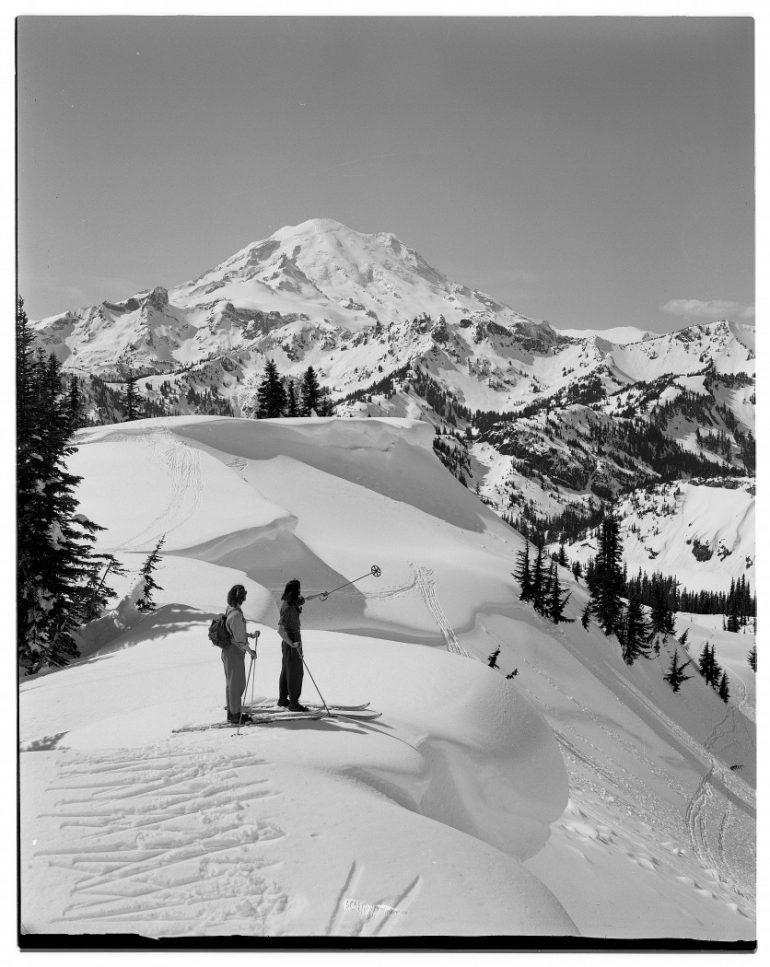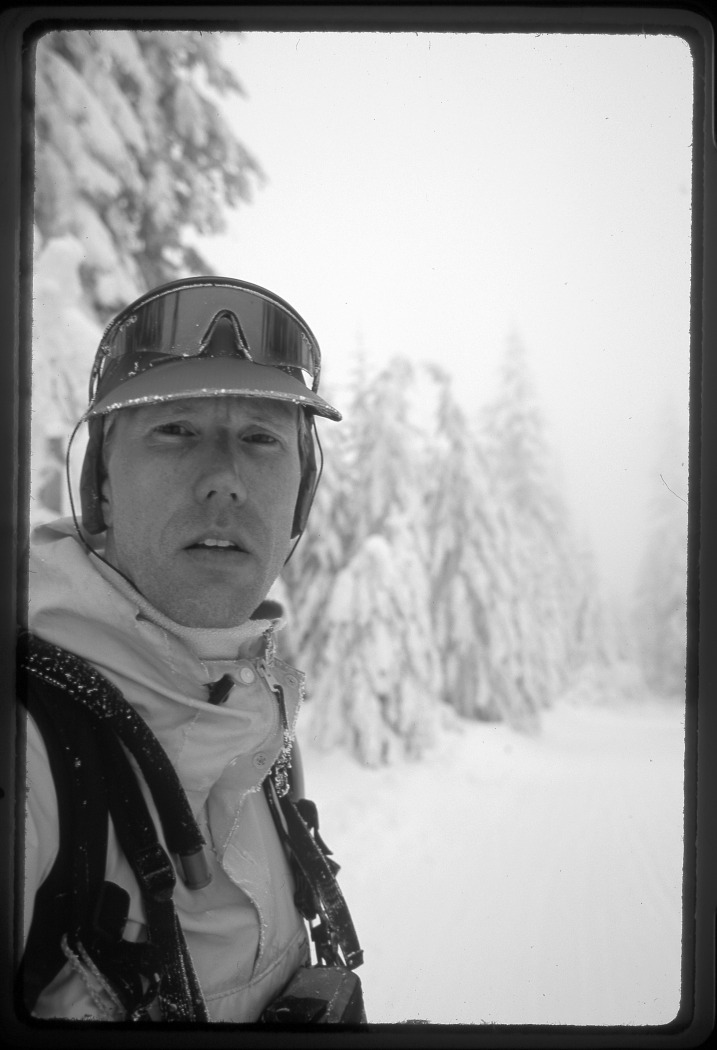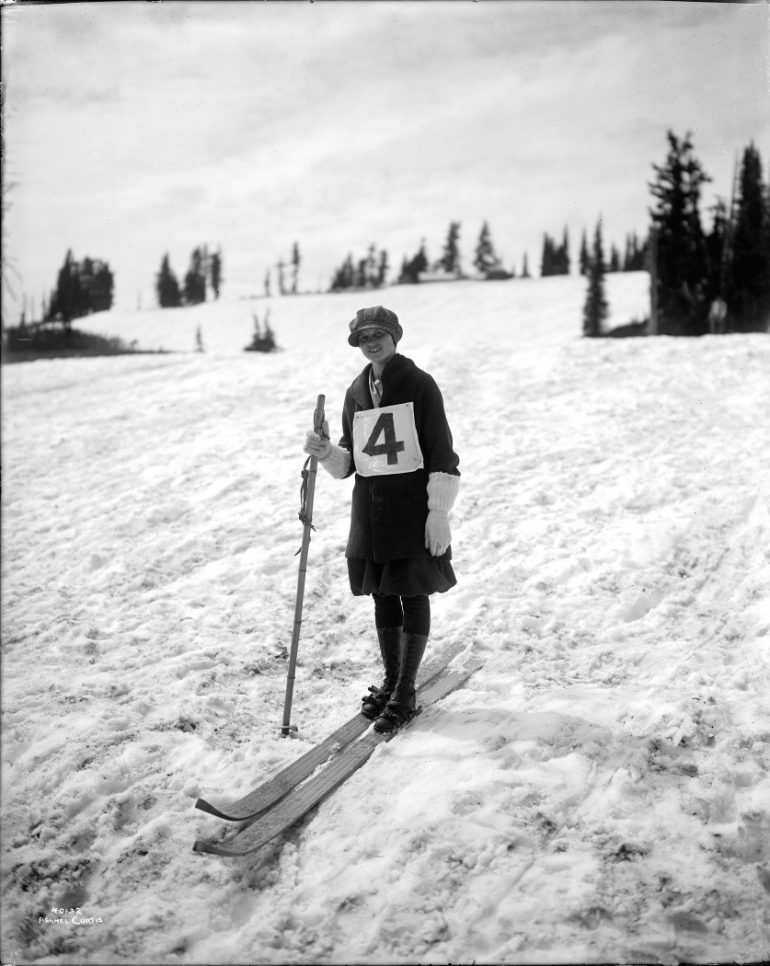
Skiers take in the view of Mount Rainier from Naches Peak near the Cayuse Pass ski area in the 1940s. (Photo: Spring trust for Trails.)
The opening lines of a 2010 piece about Lowell Skoog read, “Lowell Skoog is a thorough and meticulous guy. It’s what you need in a preservationist. Getting the details right is a required historical imperative.”
In Skoog’s recently published book Written in the Snows: Across Time on Skis in the Pacific Northwest, the finite details are all there. He opens with a ski tour atop Snoqualmie Pass in which he’s seeking markers nailed to trees back in the early 1930s, charting a 20-mile course for the inaugural Patrol Race from Snoqualmie Pass to Stampede Pass. If you take the time and imagine, there’s a part of this book where you can smell wet wool and wet fir trees in dense PNW forests, and hear the airborne silence sandwiched between takeoff and landing during the region’s carnival-like ski jumping scene.
Written in the Snows is meticulous, and throughout its over three hundred pages, Skoog does preserve Pacific Northwest skiing. The stories are here, and with his telling, they’re now unlikely to fade.

Lowell Skoog scouting The Mountaineers Patrol Race route during the winter of 2001. (Photo: Courtesy Mountaineers Books.)
Years ago, I first came across Skoog’s name reading the Northwest Mountaineering Journal. In the now-defunct publication, the stories all seemed to be improved by Skoog’s editorial fingerprints, love of history, and his ability to make ephemeral journeys long-lived. Skoog and his work also opened my eyes to the notion that descending a mountain was a whole lot more fun on skis than poking along, down-climbing in my leather Raichle hiking boots, and leaden crampons.
Skoog’s latest work is even more comprehensive than his past wordsmithing efforts and near-total in its mission – which is saying something. From the book’s beginning on Snoqualmie Pass, to the final chapter, “Beyond Boundaries”, where Skoog explores modern ski mountaineering, readers traverse a wide-ranging skiing compendium. The details are exhaustive. I absorbed the book a chapter at a time, a strategy that kept me returning, after taking time for the scenes to gel, to better understand the evolution of ski culture here in the Pacific Northwest. The Scandinavian immigrants loom large. And the iconic geographic pillars of the region, running from north to south – Mt Baker, Mt Rainier, and Mt. Hood – become characters themselves.
The read is refreshing, and even more so in a time when quotidian life is over cataloged on social media. Here’s why: we learn of skiers like Olga Bolstad, Marguerite Strizek, and Milana Jank, all icons in their own right, that on a whimsical scroll-through digital platform, I likely would have zipped right by.
Skoog thoroughly covers the fabric of PNW backcountry skiing history in the book. But he seems to know just when to meditate a bit and allow a subject to briefly blossom. Bolstad is one such example of this technique that allows Skoog to generate momentum and carry his narrative arc. In an otherwise all-male field, Bolstad won the inaugural ski tournament on Mt. Rainier back in 1917. We get the sense that Bolstad, a venerable ski jumper, broke ground. (Historical note, women’s ski jumping became an official Olympic sport nearly 100 years later in 2014 and still lags behind in terms of support from their international federation.)

Olga Bolstad won the first ski tournament held on Mount Rainier; she defeated all the male competitors. (Photo: Asahel Curtis courtesy Washington State Historical Society, WSHA.1943.42.40132.)
In imagining the skiable terrain punching upward from the Canadian border down south to the Columbia River Gorge, we consider a global gem of skiing and explorable terrain. That in and of itself is dreamy. But, Skoog also adroitly populates that terrain here and there with personalities and anecdotes worthy of further exploration. On more than one occasion, I found myself jotting down the names of notable skiers, Bolstad included, and Googling. Not all regions have a Skoog to document their skiing culture. And not all areas have a stout force of nature like Skoog, who is keener on knowing who came before and laid down the tracks than charging forward with a selfie stick for a look-at-me moment.
The book features an extensive collection of historical photographs and includes an appendix detailing the region’s ski mountaineering highlights.
The book runs 336 pages and is published by Mountaineers Press. It can be purchased for $29.95.
If you would like to learn more about Skoog’s work, you can find more at The Alpenlow Gallery..
Jason Albert comes to WildSnow from Bend, Oregon. After growing up on the East Coast, he migrated from Montana to Colorado and settled in Oregon. Simple pleasures are quiet and long days touring. His gray hair might stem from his first Grand Traverse in 2000 when rented leather boots and 210cm skis were not the speed weapons he had hoped for. Jason survived the transition from free-heel kool-aid drinker to faster and lighter (think AT), and safer, are better.

